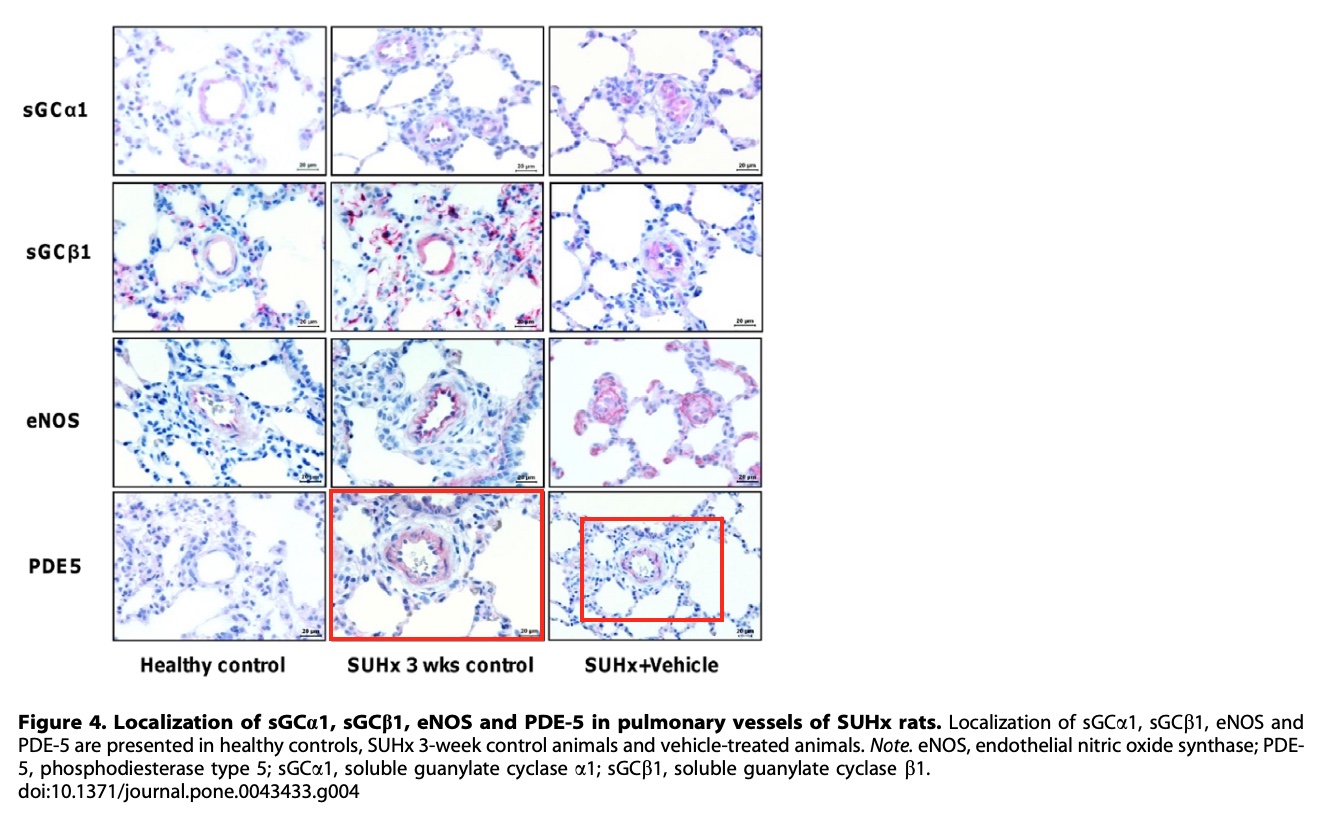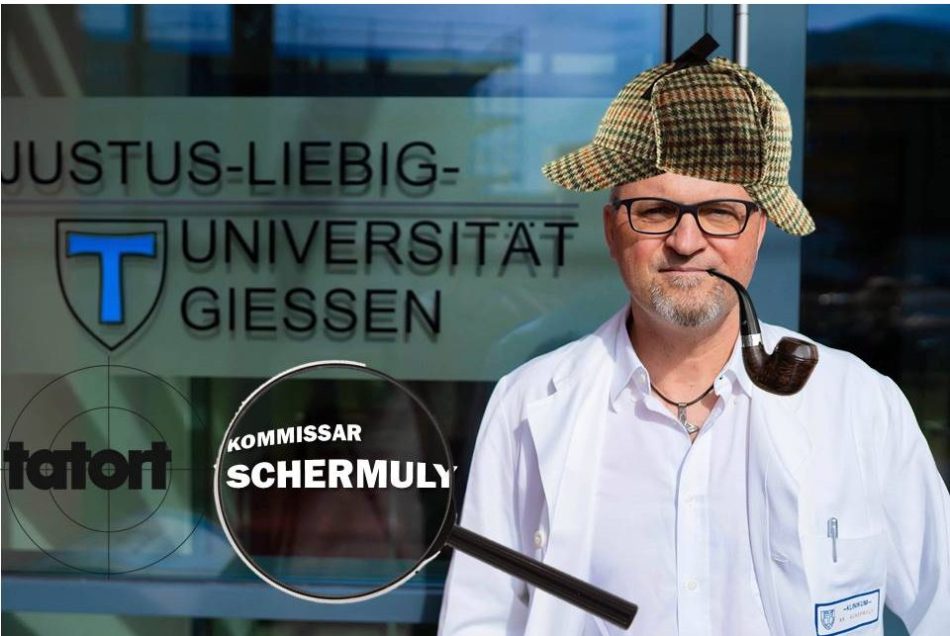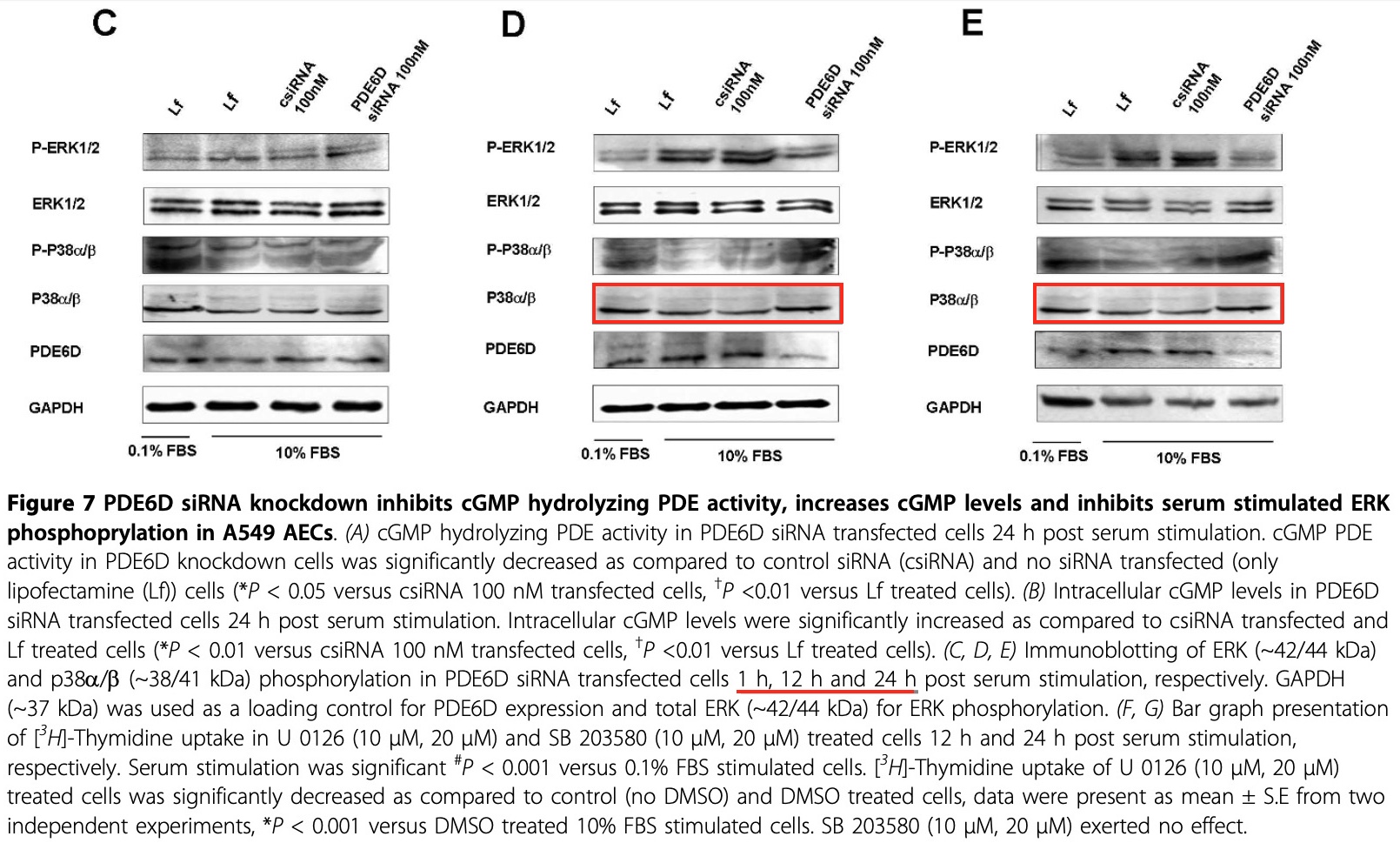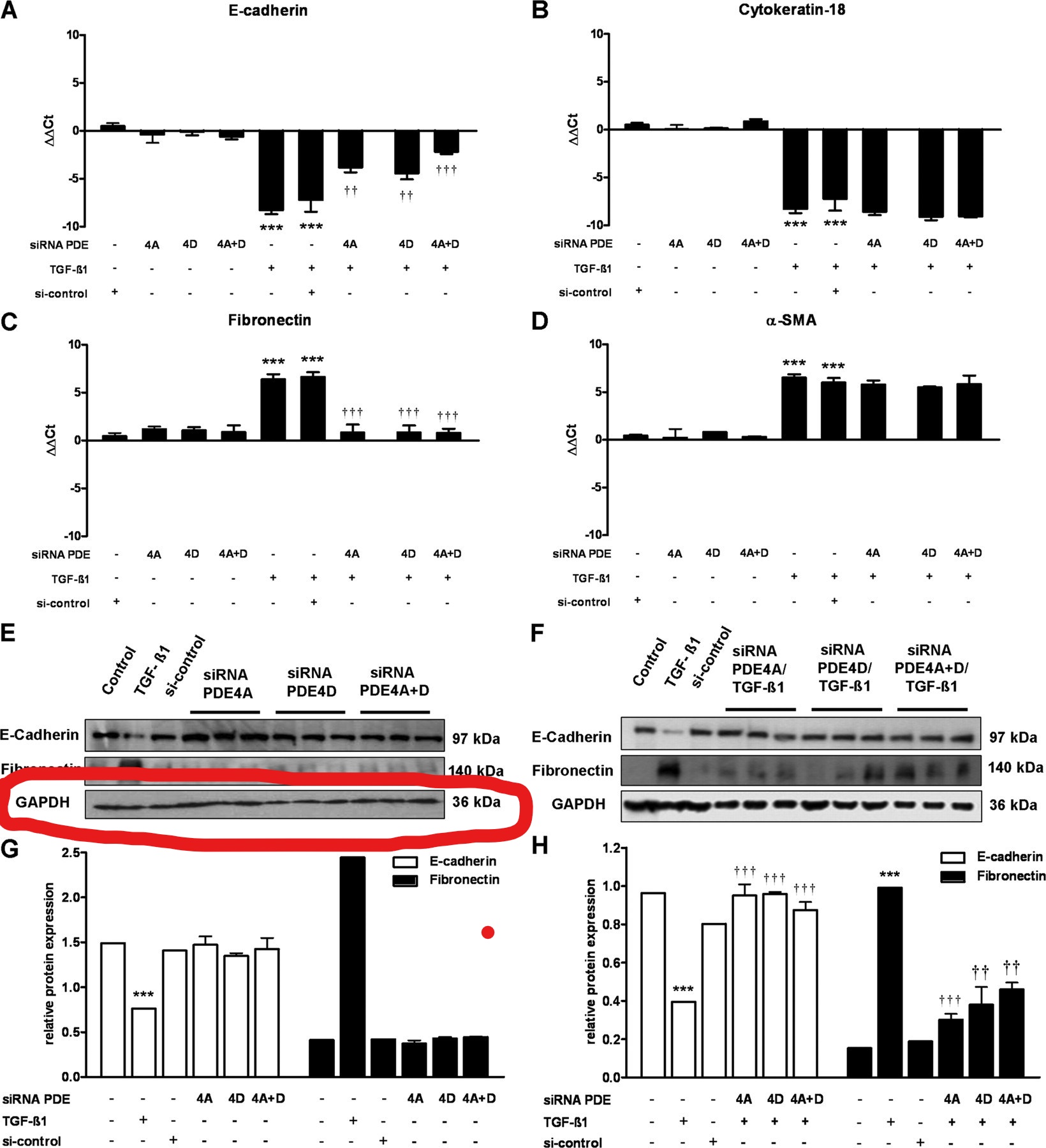Professor Ralph Schermuly is a specialist for lung hypertension at the Justus-Liebig-University Giessen in Germany, author of ~300 “from bench to bedside” papers and owner of an h-index of 70 (in 2019). More recently, the pulmonologist was appointed by his university’s Ombudsman as a crime scene detective, to figure out how the image data in some of his paper got manipulated. Corrections were announced, and apparently there is nothing else for the Giessen University Ombudsman to do while Inspector Schermuly investigates!
Here a 9-year-old study from Prof Schermuly’s lab, one out of currently 19 recorded on PubPeer. An image was clearly duplicated, showing the lung of a different rat treated differently. Probably accidentally, where the image was also accidentally zoomed in the process of accidental duplication.
Michaela Lang, Baktybek Kojonazarov , Xia Tian , Anuar Kalymbetov , Norbert Weissmann , Friedrich Grimminger , Axel Kretschmer , Johannes-Peter Stasch , Werner Seeger, Hossein Ardeschir Ghofrani , Ralph Theo Schermuly The soluble guanylate cyclase stimulator riociguat ameliorates pulmonary hypertension induced by hypoxia and SU5416 in rats PLoS ONE (2012) doi: 10.1371/journal.pone.0043433

This paper was, like several others discussed here, done in collaboration with his Giessen colleague and fellow pulmonology professor, Ardeschir Ghofrani. The next study was done in collaboration with Michaela Kuhn, pharmacology professor at the University of Würzburg. Unfortunately, some lung images got duplicated there, too.
Franziska Werner , Baktybek Kojonazarov , Birgit Gaßner , Marco Abeßer , Kai Schuh , Katharina Völker , Hideo A. Baba , Bhola K. Dahal , Ralph T. Schermuly , Michaela Kuhn Endothelial actions of atrial natriuretic peptide prevent pulmonary hypertension in mice Basic Research in Cardiology (2016) doi: 10.1007/s00395-016-0541-x

In medicine, it is common and often expected to strategically include many of your important colleagues as co-authors on our papers, a practice called gift authorships. Which of course could not have happened here, because Professor Schermuly is an upright and honest scientist, otherwise he wouldn’t have been appointed an investigator of his own papers. But then again, many of of Prof Schermuly’s co-authors are (like him!) very eminent men of German pulmonology and cardiology, and these high-ranking titans of medicine can never be associated with questionable research. So how to explain? Exactly: maybe a rogue student or nameless technician did it, and in any case, these inadvertent mistakes do not affect any of the conclusions!
Like in this study, done in collaboration with Grazyna Kwapiszewska, director of the Ludwig Boltzmann Institute for Lung Vascular Research in Graz, Austria, and many other important German and Austrian colleagues: Walter Klepetko (head of surgery clinic at MedUni Vienna), Friedrich Grimminger (described as “intellectual high-performance athlete”), plus anotherpulmonology professor in Giessen, Norbert Weissmann, and finally, a very senior figure: Werner Seeger, Medical Director of the Giessen-Marburg university hospital and department head at the Max-Planck Institute for Heart and Lung Research in Bad Nauheim. Remember that institute!
Friederike Christine Weisel , Christina Kloepping , Alexandra Pichl , Akylbek Sydykov , Baktybek Kojonazarov , Jochen Wilhelm , Markus Roth , Karen Marie Ridge , Kazuei Igarashi , Kazuhiro Nishimura , Wolfgang Maison , Claudia Wackendorff , Walter Klepetko , Peter Jaksch , Hossein Ardeschir Ghofrani , Friedrich Grimminger , Werner Seeger , Ralph Theo Schermuly, Norbert Weissmann, Grazyna Kwapiszewska Impact of S-adenosylmethionine decarboxylase 1 on pulmonary vascular remodeling Circulation (2014) doi: 10.1161/circulationaha.113.006402

A paper with such names on it can never be faulty. Surely the inset image was reused inadvertently between Figure 1 and Supplemental Figure 4, to stand for different mice in different experimental conditions, and also darkened inadvertently in the process.
Something inadvertent also happened in this paper from Prof Schermuly’s lab:
Akylbek Sydykov, Himal Luitel , Argen Mamazhakypov , Malgorzata Wygrecka , Kabita Pradhan , Oleg Pak , Aleksandar Petrovic , Baktybek Kojonazarov , Norbert Weissmann , Werner Seeger , Friedrich Grimminger , Hossein Ardeschir Ghofrani , Djuro Kosanovic , Ralph Theo Schermuly Genetic Deficiency and Pharmacological Stabilization of Mast Cells Ameliorate Pressure Overload-Induced Maladaptive Right Ventricular Remodeling in Mice International Journal of Molecular Sciences (2020) doi: 10.3390/ijms21239099

Surely pictures of different mouse hearts, genetically different or treated with different drugs, cannot be derived from the same large continuous image? Maybe a student did it, who left the lab long ago? Hopefully the rogue student did not take the raw data with them, the paper is from last year!

Here a collaboration of Schermuly and the “intellectual high-performance athlete” Grimminger with Ghazwan Butrous, professor at the University of Kent in UK.
Ewa Kolosionek , Jayne King , David Rollinson , Ralph Theo Schermuly , Friedrich Grimminger , Brian B. Graham , Nicholas Morrell , Ghazwan Butrous Schistosomiasis causes remodeling of pulmonary vessels in the lung in a heterogeneous localized manner: Detailed study Pulmonary Circulation (2013) doi: 10.4103/2045-8932.114764
It is quite unlikely that different granulomas in different Schistosoma-infected mice would look so similar. It is also unlikely that a sequential slice 45 would look exactly just like slice 30, just stretched. Maybe inspector Schermuly can investigate?
Before we move on, here is what the newly appointed Ombudsman of the Giessen University, the food chemistry professor Gerd Hamscher, told me, when I notified him in the first days of September 2021 of the PubPeer concerns about Schermuly’s papers:
“Thank you for your feedback and the well-documented preliminary investigation.
The basic procedure at JLU now looks like this (https://www.uni-giessen.de/mug/5/pdf/forschung/5_00_10_1_Neufassung):
“If there is a suspicion of scientific misconduct, an ombudsperson examines the allegations. If they cannot resolve them in the course of their preliminary investigations, they submit the report on the suspicion to the Standing Commission. Those affected by the suspicion of misconduct are given the opportunity to comment. The deadline for this is usually three weeks, during the lecture-free period six weeks. After a subsequent preliminary examination by the chairman of the Standing Committee (within four or eight weeks), it is decided whether a formal investigation procedure should be initiated. Those affected are given the opportunity to comment in any case. The commission reports to the president and makes suggestions as to which further legal steps should be taken. The president of the university decides whether legal, academic or criminal consequences are to be drawn. “
In this respect, as the ombudsperson, I will first carry out a further examination of the allegations and I already asked the (main) person concerned for a statement.“
On 4 October, one month has passed, I saw yet another paper from Schermuly lab flagged on PubPeer, and sent it to Hamscher.
Baktybek Kojonazarov , Akylbek Sydykov , Soni Savai Pullamsetti , Himal Luitel , Bhola K. Dahal , Djuro Kosanovic , Xia Tian , Matthaeus Majewski , Christin Baumann , Steve Evans , Peter Phillips , David Fairman , Neil Davie , Chris Wayman , Iain Kilty , Norbert Weissmann , Friedrich Grimminger , Werner Seeger, Hossein Ardeschir Ghofrani , Ralph Theo Schermuly Effects of multikinase inhibitors on pressure overload-induced right ventricular remodeling International Journal of Cardiology (2013) doi: 10.1016/j.ijcard.2012.06.129

A inadvertently duplicated image showing different rat hearts, possibly slightly brightened. Hamscher announced to check it and to forward it to Schermuly. Oh well. On 16 October 2021, I wrote to Hamscher again, sending him this, three papers with bizarrely recycled images.
Grant R. Budas , Mario Boehm , Baktybek Kojonazarov , Gayathri Viswanathan , Xia Tian , Swathi Veeroju , Tatyana Novoyatleva , Friedrich Grimminger , Ford Hinojosa-Kirschenbaum , Hossein A. Ghofrani , Norbert Weissmann , Werner Seeger , John T. Liles , Ralph T. Schermuly ASK1 Inhibition Halts Disease Progression in Preclinical Models of Pulmonary Arterial Hypertension American Journal of Respiratory and Critical Care Medicine (2018) doi: 10.1164/rccm.201703-0502oc
Mario Boehm , Nadine Arnold , Adam Braithwaite , Josephine Pickworth , Changwu Lu , Tatyana Novoyatleva , David G. Kiely , Friedrich Grimminger , Hossein A. Ghofrani , Norbert Weissmann , Werner Seeger , Allan Lawrie , Ralph T. Schermuly, Baktybek Kojonazarov Eplerenone attenuates pathological pulmonary vascular rather than right ventricular remodeling in pulmonary arterial hypertension BMC Pulmonary Medicine (2018) doi: 10.1186/s12890-018-0604-x
Mario Boehm , Tatyana Novoyatleva , Baktybek Kojonazarov , Florian Veit , Norbert Weissmann , Hossein A. Ghofrani , Werner Seeger , Ralph T. Schermuly Nitric Oxide Synthase 2 Induction Promotes Right Ventricular Fibrosis American Journal of Respiratory Cell and Molecular Biology (2019) doi: 10.1165/rcmb.2018-0069oc

The evidence is staggering. I asked if an investigation was opened by now and if the German Research Council (DFG) was informed. Maybe also Hamscher was overwhelmed, in any case it took him 9 days to reply with:
“At this point, I can inform you that after consulting the ombudsperson, Prof. Schermuly is currently checking all listed articles – also in consultation with the responsible co-authors – and will then clarify about the necessary corrections at the level of the journals and their editors. This will take some time.
Until then, I ask for your patience“
I then asked Hamscher if this really means the Giessen University decided against a formal investigation, against informing the DFG, and instead outsources the investigation to Schermuly, his coauthors and the journals where their papers were published. I specifically invited Hamscher to deny or correct this interpretation, to which he replied by warning me that I am not allowed to pass on any of his communications to third parties.
Thing is, according to those same guidelines Hamscher sent me before, he should have forwarded the case to the Standing Commission for investigation if any suspicions for research misconduct manifested themselves. Since Hamscher did not do that, this would imply that the initial suspicions of research misconduct were ruled out, because clearly all those alleged image duplications are false alarms, or at least accidental, inadvertent, and do not affect any of the conclusions. This must be why Hamscher keeps forwarding all the PubPeer evidence not to the Standing Commission, but to the only expert he saw as qualified to manage this affair: Prof Schermuly.
Incidentally, one member of the Standing Commission, the Giessen University pulmonology professor Susanne Herold, has a joint paper with Schermuly criticised for undisclosed gel splicing. This is why I agree it is really the best solution to let Prof Schermuly investigate this affair himself, and to let him issue corrections where he sees a need.
In his last email to me, Hamscher stated that his investigation is not over yet and announced to follow up on further evidence I submitted. Evidence like this:
Soni Savai Pullamsetti , Rajkumar Savai , Rio Dumitrascu , Bhola Kumar Dahal , Jochen Wilhelm , Melanie Konigshoff , Dariusz Zakrzewicz , Hossein Ardeschir Ghofrani , Norbert Weissmann , Oliver Eickelberg , Andreas Guenther , James Leiper , Werner Seeger, Friedrich Grimminger , Ralph Theo Schermuly The role of dimethylarginine dimethylaminohydrolase in idiopathic pulmonary fibrosis Science Translational Medicine (2011) doi: 10.1126/scitranslmed.3001725


Of course these images, purportedly showing the lungs from genetically different mice, must have been reused accidentally. In this regard, meet a regular collaborator of Prof Schermuly, Soni Pullamsetti, professor at the Giessen University and now also group leader at the Max-Planck Institute for Heart and Lung Research in Bad Nauheim (where Seeger runs a department). Prof Pullamsetti has 9 papers on PubPeer, 7 of those with Schermuly. Her speciality is also pulmonary hypertension, but also cancer research, where she is “forwarding therapeutic concepts from “Bench to Bedside”.” Here one such study:
R. Dumitrascu , C. Kulcke , M. Konigshoff , F. Kouri , X. Yang , N. Morrell , H. A. Ghofrani , N. Weissmann , R. Reiter , W. Seeger, F. Grimminger , O. Eickelberg , R. T. Schermuly, S. S. Pullamsetti Terguride ameliorates monocrotaline-induced pulmonary hypertension in rats European Respiratory Journal (2011) doi: 10.1183/09031936.00126010

It is not entirely clear how rats from different treatment groups got to partially share a lung image, which however changed colour in the process so it’s probably OK, right?
The following concern about cloned cells cannot really be explained, but I assume the figure was redundant anyway, its removal would not affect the conclusions.
Ewa Kolosionek , Rajkumar Savai , Hossein Ardeschir Ghofrani , Norbert Weissmann , Andreas Guenther , Friedrich Grimminger , Werner Seeger, Gamal Andre Banat , Ralph Theo Schermuly, Soni Savai Pullamsetti Expression and activity of phosphodiesterase isoforms during epithelial mesenchymal transition: the role of phosphodiesterase 4 Molecular Biology of the Cell (2009) doi: 10.1091/mbc.e09-01-0019

Update 29.10.2021: It seems, Inspector Schermuly doesn’t investigate all by himself anymore. Now Professor Pullamsetti explained on PubPeer what the above image shows:
“it is important to note that not every epithelial cell will undergo for epithelial mesenchymal transition, and thus may preserve their epithelial cell phenotype. That´s why some of the TGF-β1 stimulated cells may look similar to control cells, but it is definitely not a duplication.”
The plot thickens!
Nobody from the Max Planck Institute in Bad Nauheim replied to my emails, I guess they decided there is really nothing to worry about or to waste time investigating. After all, Prof Hamscher does a great job forwarding the PubPeer threads to Prof Schermuly already.
Like here, those are just representative images of lungs, they are not supposed to be accurate or truthful.
Rajkumar Savai , Soni S. Pullamsetti , Julia Kolbe , Ewa Bieniek , Robert Voswinckel , Ludger Fink , Axel Scheed , Christin Ritter , Bhola K. Dahal , Axel Vater , Sven Klussmann , Hossein A. Ghofrani , Norbert Weissmann , Walter Klepetko , Gamal A. Banat , Werner Seeger , Friedrich Grimminger , Ralph T. Schermuly Immune and inflammatory cell involvement in the pathology of idiopathic pulmonary arterial hypertension American Journal of Respiratory and Critical Care Medicine (2012) doi: 10.1164/rccm.201202-0335oc

Yes, one image is supposed to be of a lung and its enlargement is supposed to show the pulmonary artery, while the scale bars remained the same. But it passed peer review, so yes, it is OK like this.
Now, some papers are too old to ask for raw data anyway:
Sergey Udalov , Rio Dumitrascu , Soni S Pullamsetti , Hamza M Al-tamari , Norbert Weissmann , Hossein A Ghofrani , Andreas Guenther , Robert Voswinckel , Werner Seeger, Friedrich Grimminger , Ralph T Schermuly Effects of phosphodiesterase 4 inhibition on bleomycin-induced pulmonary fibrosis in mice BMC Pulmonary Medicine (2010) doi: 10.1186/1471-2466-10-26

Sure, those are the lungs of differently treated mice, but come on, the paper is 11 years old. Which by extension should mean it would be inappropriate to ask for raw data in all the other papers.
One more to conclude, with all the big names on it.
Sevdalina Nikolova , Andreas Guenther , Rajkumar Savai , Norbert Weissmann , Hossein A Ghofrani , Melanie Konigshoff , Oliver Eickelberg , Walter Klepetko , Robert Voswinckel , Werner Seeger, Friedrich Grimminger , Ralph T Schermuly, Soni S Pullamsetti Phosphodiesterase 6 subunits are expressed and altered in idiopathic pulmonary fibrosis Respiratory Research (2010) doi: 10.1186/1465-9921-11-146
I personally think the fact that the western blots for the samples from 12h and 24h treatment look so similar proves exactly how trustworthy and reproducible the results are!
Incidentally, there was a late German TV actor called Ralph Schermuly, who used to feature in old crime series. I don’t know if these two Ralphs Schermulys are related, but the pulmonology professor does a great job as a fictional inspector!

Make a one-time donation
Make a monthly donation
Choose an amount
Or enter a custom amount
Your contribution is appreciated.
Your contribution is appreciated.
DonateDonate monthly


Conclusions not affected anyway. Biology is not an experimental nor a natural science, the only thing that matters is that the reasoning makes sense
(Yes I am joking, just in case)
LikeLike
Congratulations, you now qualified to serve as a university Ombudsman!
LikeLike
The Max Planck Society (MPG) and its MPI in Bad Nauheim finally replied after I asked if their silence is to be interpreted as utter disinterest.
Especially in view of this peculiar PubPeer comment by their scientist Pullamsetti.
Stefan Offermanns, the institute’s scientific director just wrote to me:
“The MPI for Heart and Lung Research is of course interested in an comprehensive and appropriate investigation. For this reason, the MPI has asked for an independent review by the compliance office of the MPG in accordance with the procedures of the MPG.“
LikeLike
Now the Giessen University Ombudsman wrote to me:
“I forwarded your notification of suspicion against Prof. Schermuly in connection with the allegations against Prof. Pullamsetti – after the examination to clarify the matter in my function as ombudsperson – to the chairman of the standing commission for ensuring of good scientific practice.at the Justus Liebig University Giessen.
A further preliminary check is carried out here in accordance with our statutes. I had already provided you with the relevant content and time frames in my email.
Thank you for your extensive preliminary investigations and best regards
Gerd Hamscher”
If any journalists read this: this is how easy it is to make universities take notice of bad science and open investigations. All you have is to do is to make this public.
LikeLiked by 1 person
Tomorrow’s email: “After careful review of the relevant facts, the Ombudsman has determined that there is insufficient evidence of misconduct to initiate a full investigation.”
LikeLike
Nope, now they have to investigate!
LikeLike
More on that wretched Kolosionek et al 2009 paper



https://pubpeer.com/publications/3E21FC25FC2745153CB30E8FDE98C2#5
Figure 10 B and G represent different experiments but use same GAPDH blots.
LikeLike
One truth that is missing in these arguments about the Schermuly lab is that the therapeutic efficacy of the targets he investigated and agents he and his team evaluated are reproducible not only in preclinical models but also in patients! For example, the beneficial effects of Pde5 inhibition are proven in PAH patients (Sildenafil and tadalafil are first line therapies for PAH) and the benefit of imatinib is proven in clinical trials (see data on Ph3 IMPRES trial). These achievements are more than most authors on any journal can ever claim and have provided real value for patients.
LikeLike
Danke für Ihre Ausführung. Als Lungenhochdruckerkrankte kann ich dem nur zustimmen.
Leider konnte ich nicht in Erfahrung bringen, wann die Forschung zu den Braunalgen in Gießen fortgesetzt wird.
In den USA, Dänemark und Tibet und weiteren Ländern laufen die Studien weiter. Traurig.
LikeLike
Ich würde eher fragen, warum sie dort laufen, wenn die wissenschaftliche Lage keine Voraussetzung für Menschenversuche bietet.
LikeLike
Ganz allgemein: oft reicht es für die Genehmigung einer klinischen Studie die Unbedenklichkeit bezüglich der Verträglichkeit. Ohne vorklinische Hinweise dass die Substanz überhaupt eine Wirkung haben könnte. Bei Lebensmitteln ist das ganz einfach.
LikeLike
In meinem Kommentar zu Ihrem Artikel wurde ein Satz nicht korrekt angezeigt. Er sollte heißen: “Leider konnte ich nicht heraus finden, wann die Forschung zu den Braunalgen in Gießen fortgesetzt wird.”
LikeLike
Als Lungenhochdruck-Patient interessiert mich vor allem, ob die Forschung bzgl Braunalgen wieder aufgenommen und fortgeführt wird.
Mich interessiert wenig, ob die Dokumentation fehlerhaft gemacht wurde, sondern vielmehr, ob ein Medikament entwickelt werden kann, das uns Lungenhochdruckerkrankten ein Überleben ermöglicht.
LikeLike
Als Patient soll man schon ein Interesse daran haben, nicht für gefälschte Forschung geopfert zu werden.
Ja, man kann aus Betrug Medikamente entwickeln. Funktionieren sie trotzdem? Naja, sind Autos mit gefälschten Bremsen und Airbags sicher?
LikeLike
Sad to see this type of scientific misconduct. Hope this investigation’s uncover the truth and maintain Research integrity so that nothing will happen like this in future.
LikeLike